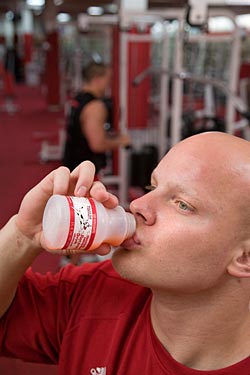UW Badgers, farmers enjoy benefits of whey sports drink
When the University of Wisconsin football Badgers take the field this fall, they will have a secret weapon behind them: Wisconsin’s dairy cows.

Ben Herbert, assistant strength and conditioning coach for the Badger football team, takes a drink of a recovery beverage made from whey. The drink was formulated for UW–Madison athletes and is produced on campus at the Babcock Hall Dairy Plant.
Photo: Wolfgang Hoffmann
Sure, they might not run very well or catch a football, but cows supply one of the key ingredients in a sports recovery drink that the Badgers use to bounce back from strenuous workouts and practices.
Made specially for the team by UW–Madison’s Babcock Dairy Plant, the drink contains protein from whey, a byproduct of cheese production, known to help muscles recover from hard exercise. Team members drain bottles of the drink following weightlifting sessions and practices.
"It’s been great for us," says Ben Herbert, assistant strength and conditioning coach for the football team, who was a Badger defensive end from 1998 until 2002. "A lot of these supplements don’t taste very good. This gives us what we need, and the guys really like to drink it."
As an agricultural commodity, whey has a rags-to-riches story nearly as dramatic as the Badgers’ rise to the football elite. For many years, farmers used it to fertilize fields or feed hogs. Then, scientists figured out how to isolate and dry the protein contained in whey, making it a promising dietary supplement for athletes in training. Weightlifters began using it in the 1980s to promote muscle recovery and repair, and the protein has since emerged as a mainstream health-promoting nutritional supplement.
Whey protein’s superior muscle-repairing and muscle-building properties arise in part from its unique chemical makeup. While all proteins are made of chemical units called amino acids, whey protein contains a high proportion of a particular type of amino acid, called branched chain amino acids, that muscle cells can absorb easily and directly from the bloodstream. Other amino acids must first be processed by the liver before being absorbed. These fast-acting amino acids kick-start muscle growth and contribute to the development of lean body mass.
With these benefits in mind, Jeremy Isensee, a nutritionist who began working with the UW–Madison football team in 2000, proposed the idea for the campus-made sports recovery drink.
"There was another drink the football team was purchasing at the time that had some whey protein in it," explains K.J. Burrington, a researcher who formulated the beverage at the Wisconsin Center for Dairy Research (WCDR), an on-campus center that promotes the dairy industry and receives significant funding from state dairy farmers. "But Jeremy Isensee didn’t like the fact that it had high fructose corn syrup in it."
Instead, the UW–Madison’s version contains two carbohydrates – dextrose and maltodextrin – that the body may digest more slowly, keeping blood sugar levels relatively steady. The Babcock Hall Dairy Plant began supplying this beverage to the football team, as well as the men’s and women’s basketball and hockey teams, starting in June 2006.
In formulating the recovery drink, Burrington choose whey protein from Grande Cheese Company, a WCDR industry member headquartered in Lomira, Wis. The company makes a highly concentrated whey protein powder, called Grande Ultra 8000, from the whey generated during the production of a natural white Italian cheese. "Grande’s [whey protein] has a very clean flavor," says Burrington. "It’s a highly functional product with great solubility and heat stability."
While other market forces are certainly at play, value-added whey protein products such as Grande Ultra 8000 are helping to drive up the price of dried whey, a commodity that influences the amount farmers are paid for their milk. In April, the price of dried whey reached a record high, selling for 78 cents per pound, more than triple its long-term average price of about 20 cents per pound. Although dried whey is just one factor in the equation used to set milk price, it’s having a palpable affect.
"This extra dried whey value [has led to] approximately a 20 percent increase in class III milk price over the 2006 average, " says Brian Gould, UW–Madison professor of agricultural and applied economics, referring to the financial impact of whey on the type of milk used for cheesemaking, which comprises roughly 85 percent of milk produced in Wisconsin. According to Gould, whey can help generate revenue for cheese companies, too, when it is dried and further processed into high-end protein products in-house.
Demand for whey protein will likely expand in coming years, as researchers continue to find new and important applications for it. Recent studies indicate that whey protein may help lower blood pressure, mitigate glucose and insulin responses in pre-diabetics, and help dieters control their hunger.
Babcock’s whey protein-fortified drink, which is simply called "Recovery Drink," comes in orange and strawberry flavors, and can be found in Babcock Deli’s cold case alongside bottles of chocolate and regular milk.
Tags: biosciences, health & medicine, UW Athletics


